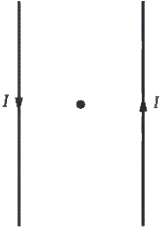(Multiple choice) (1) The Biot--Savart law is similar to Coulomb's law in that both (a) Are inverse...
Question:
(Multiple choice)
(1)
The Biot--Savart law is similar to Coulomb's law in that both
(a) Are inverse square laws.
(b) Deal with forces on charged particles.
(c) Deal with excess charges.
(d) Include the permeability of free space.
(e) Are not electrical in nature.
(2)
Two wires lie Figure Problem 19 in the plane of the paper and carry equal currents in opposite directions, as shown in Figure. At a point midway between the wires, the magnetic field is
(a) Zero.
(b) Into the page.
(c) Out of the page
(d) Toward the top or bottom of the page.
(e) Toward one of the two wires.

(3)
Two parallel wires carry currents I1 and I2 = 2I1 in the same direction. The forces F1 and F 2 on the wires are related by
(a) F1 =F2.
(b) F1 = 2F2.
(c) 2F1 = F2.
(d) F1 =4F2.
(e) 4F1 = F2.
(4)
A wire carries an electrical current straight up. What is the direction of the magnetic field due to the wire a distance of 2 m north of the wire?
(a) North
(b) East
(c) West
(d) South
(e) Up ward
(5)
Two current-carrying wires are perpendicular to each other. The current in one flows vertically upward and the current in the other flows horizontally toward the east. The horizontal wire is one meter south of the vertical wire. What is the direction of the net magnetic force on the horizontal wire?
(a) North
(b) East
(c) West
(d) South
(e) There is no net magnetic force on the horizontal wire.
(6)
Ampere's law is valid
(a) When there is a high degree of symmetry.
(b) When there is no symmetry.
(c) When the current is constant.
(d) When the magnetic field is constant.
(e) In all of these situations if the current is continuous.
(7) True or false:
(a) Diamagnetism is the result of induced magnetic dipole moments.
(b) Paramagnetism is the result of the partial alignment of permanent magnetic dipole moments.
(8)
If the magnetic susceptibility is positive,
(a) Paramagnetic effects or ferromagnetic effects must be greater than diamagnetic effects.
(b) Diamagnetic effects must be greater than paramagnetic effects.
(c) Diamagnetic effects must be greater than ferromagnetic effects.
(d) Ferromagnetic effects must be greater than paramagnetic effects.
(e) Paramagnetic effects must be greater than ferromagnetic effects.
(9) True or false:
(a) The magnetic field due to a current element is parallel to the current element.
(b) The magnetic field due to a current element varies inversely with the square of the distance from the element.
(c) The magnetic field due to a long wire varies inversely with the square of the distance from the wire.
(d) Ampere's law is valid only if there is a high degree of symmetry.
(e) Ampere's law is valid only for continuous currents.
Step by Step Answer:

Fundamentals of Ethics for Scientists and Engineers
ISBN: 978-0195134889
1st Edition
Authors: Edmund G. Seebauer, Robert L. Barry





